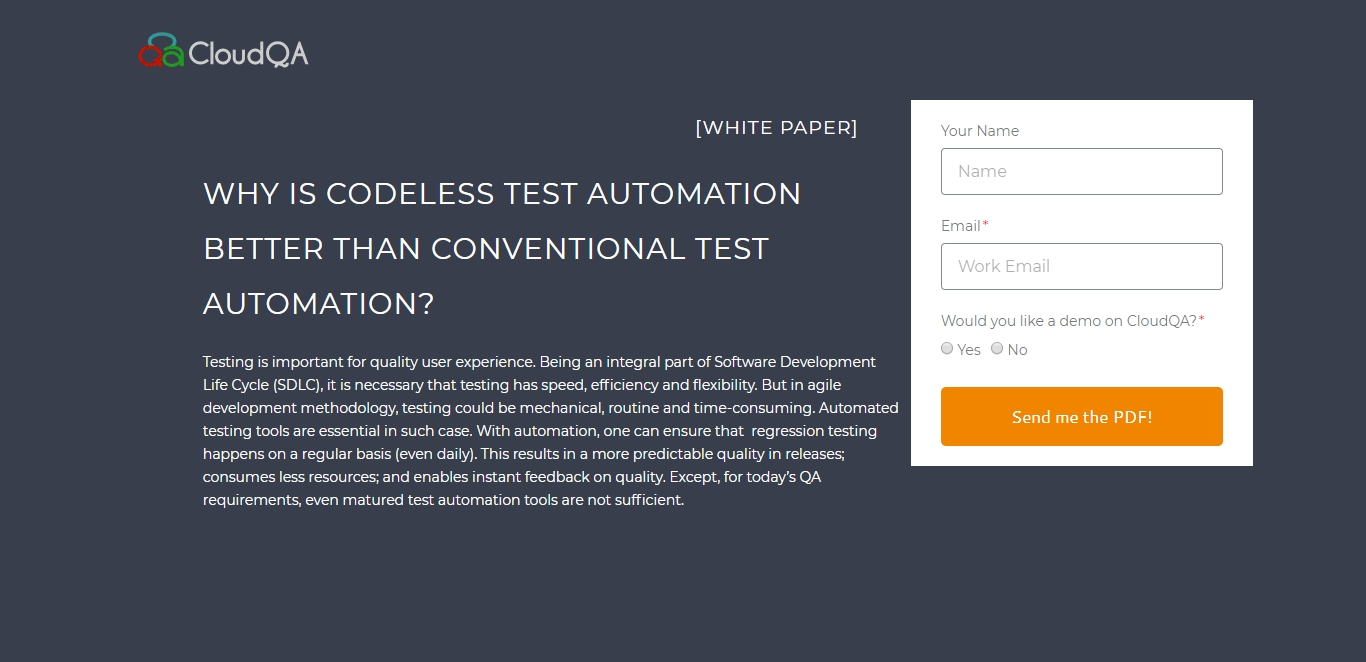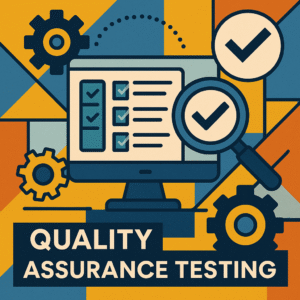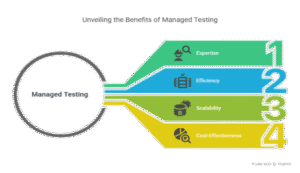The True Cost of Software Bugs in 2025: A Deep-Dive Industry Analysis
Last Updated: December 9th 2025
Is your team spending more time fixing bugs than building features? The data shows you’re not alone. Don’t let hidden software quality costs dictate your budget and timeline. See how TruRT’s resilient, self-healing regression testing can help you ship faster with confidence. Book a demo today
Table of Contents
Software bugs are an inevitable part of the development process. But while often treated as minor operational hurdles, their cumulative impact represents one of the most significant—and often underestimated—drains on the modern digital economy. They are far more than mere annoyances; they are a direct tax on innovation, a drain on financial resources, and a critical threat to customer loyalty.
To quantify this impact, we analyzed key industry reports, academic research, and proprietary data to establish a definitive benchmark for the real cost of software bugs in 2025.
The Bottom Line Up Front: The Staggering Financial Impact
Let’s begin with the most crucial figure. According to the latest analysis from the Consortium for Information & Software Quality (CISQ), a body co-sponsored by the Object Management Group (OMG) and the Software Engineering Institute (SEI) at Carnegie Mellon University:
The cost of poor software quality in the United States has reached an estimated $2.41 trillion.
This staggering number is not just about fixing code. It encompasses the massive downstream effects of software failure, including unsuccessful projects, legacy system problems, cybersecurity failures, and significant operational glitches.
Key Software Bug Statistics for 2025
To understand the components of that multi-trillion-dollar figure, it’s essential to look at the specific metrics that define the day-to-day impact of software defects. Here are the most critical statistics for business leaders, developers, and QA professionals to know.
Financial & Economic Impact
- The “Rule of 100”: A bug fixed during the design phase is 100 times cheaper to resolve than the same bug found in a production environment. (Source: IBM Systems Sciences Institute)
- The Cost of Downtime: For enterprise-level companies, the average cost of a single hour of critical application downtime is over $300,000, with some outages easily surpassing $1 million per hour. (Source: Gartner)
- Security Breach Costs: Software vulnerabilities are a leading cause of data breaches. The average cost of a data breach in the US has now hit $9.44 million. (Source: IBM’s Cost of a Data Breach Report)
Operational & Productivity Impact
- The Maintenance Tax: Development teams spend, on average, 30-50% of their time fixing bugs and dealing with unplanned rework. This is time stolen directly from new feature development and innovation. (Source: State of DevOps Report)
- Context Switching Penalty: A single interruption, such as an urgent bug report from production, can take a developer up to 23 minutes to recover from and regain full focus, severely hampering productivity. (Source: University of California, Irvine)
- The Flakiness Factor: An estimated 15-30% of all automated test failures are due to “flaky tests”—tests that fail due to instability in the test itself or the environment, not a genuine software bug. Each instance requires valuable engineering time to investigate.
Customer & Brand Impact
- The Digital Patience Threshold: 68% of users will abandon an application after encountering just two software bugs or glitches. In the competitive SaaS market, the second chance is rarely given.
- Reputation Damage: 88% of users are less likely to use a company’s app if they’ve had a bad experience with it. Negative reviews and word-of-mouth spread quickly, creating a lasting stain on brand reputation.
- Cart Abandonment: In e-commerce, a single bug in the checkout process can lead to cart abandonment rates of over 75%, representing millions in lost revenue.
The Exponential Cost: Why Finding Bugs Early is Critical
The most crucial concept in understanding bug economics is the exponential cost increase as a defect progresses through the Software Development Lifecycle (SDLC).
The “Rule of 100” from IBM provides a simple but powerful framework:
- Cost to fix in Requirements/Design Phase: ~$100
- Cost to fix in Coding/Unit Testing Phase: ~$1,000
- Cost to fix in System/Integration Testing Phase: ~$10,000
- Cost to fix in Production/Post-Release Phase: ~$100,000+
This escalation occurs because of a compounding effect. A bug in the requirements phase is a simple documentation change. Once code is written, a fix requires developer time, a new build, and re-testing. In production, a fix involves not only all the previous steps but also customer support, potential data correction, patch deployment, and brand damage control.
This economic reality is the driving force behind the “shift-left” testing movement, a strategy focused on integrating quality assurance practices as early as possible in the development pipeline to catch defects when they are orders of magnitude cheaper to resolve.
Beyond the Balance Sheet: The Hidden Costs of Poor Software Quality
While the direct costs are alarming, the indirect, “hidden” costs of software bugs are often more corrosive to a business in the long run.
Eroded Developer Morale and Productivity
Constant firefighting of production bugs is a leading cause of developer burnout. When engineers spend their days patching legacy code and investigating vague bug reports instead of building exciting new features, job satisfaction plummets. This creates a vicious cycle: low morale leads to higher employee turnover, which leads to knowledge gaps and, inevitably, more bugs. This ever-increasing technical debt acts like a high-interest loan on your codebase, making every future change slower and more difficult.
Damaged Brand Reputation and Customer Churn
In the SaaS economy, customer experience (CX) is paramount. A buggy, unreliable product is a direct assault on CX. A single critical bug can erode years of brand trust. While your team fixes the issue, your competitors are actively marketing their stable, reliable solutions to your frustrated customers. The cost here isn’t just the lost subscription fee from one user; it’s the loss of their entire lifetime value and the negative social proof they spread.
Stifled Innovation and Opportunity Cost
Every hour your best engineers spend fixing a preventable bug is an hour they aren’t spending on innovation. This is the opportunity cost of poor quality. While your team is bogged down in maintenance, your competitors are shipping new features, entering new markets, and capturing market share. In a fast-moving digital world, the company that can innovate fastest wins, and you can’t be fast if you’re constantly tripping over your own technical debt.
The Strategic Solution: Mitigating Costs with a Modern QA Mindset
The data is clear: reactive bug fixing is a losing strategy. The most successful organizations treat quality assurance not as a final-stage gatekeeper, but as a proactive, integrated discipline focused on prevention.
Embracing Comprehensive Regression Testing
One of the most common sources of costly production bugs is the regression bug—an issue where a new code change inadvertently breaks existing functionality. A robust regression testing strategy is the most effective safety net to prevent this. By creating a comprehensive suite of tests that validates core functionality after every change, teams can deploy with confidence.
The ROI of Test Automation
While manual testing has its place, it cannot scale to meet the demands of modern CI/CD pipelines. Test automation delivers a powerful ROI by providing fast, consistent feedback, allowing teams to catch regressions in minutes, not days. The upfront investment in automation tools and practices pays for itself by reducing the number of costly bugs that escape to production.
The Rise of Resilient, Codeless Solutions
However, traditional test automation has its own hidden cost: test maintenance. As we’ve seen, up to 30% of test failures are flaky, often due to brittle test scripts that break with minor UI changes. This is why a new generation of codeless test automation platforms is gaining traction. By using AI-powered, self-healing selectors (like TruRT), these tools can adapt to application changes, drastically reducing test maintenance overhead and ensuring the QA process accelerates, rather than hinders, development.
Conclusion: Shifting Your Perspective on Quality Assurance
The true cost of a software bug is not the few hours it takes a developer to fix it. It’s the lost customers, the delayed product launches, the burnt-out engineers, and the millions in lost opportunity.
By understanding these multifaceted costs, business leaders can reframe their thinking. Quality Assurance is not a cost center; it’s a profit-protection center. Investing in a modern, resilient, and automated testing strategy is one of the most high-leverage investments a technology company can make to secure its long-term success and profitability.
Methodology and Sources
This analysis is based on a synthesis of data from the following authoritative sources, accessed in 2025:
- The Consortium for Information & Software Quality (CISQ), “The Cost of Poor Software Quality in the US: A 2022 Report”
- IBM Systems Sciences Institute & IBM’s “Cost of a Data Breach Report 2023”
- Gartner Research, various reports on IT Downtime and Operational Resilience
- The “State of DevOps Report” by Puppet/CircleCI
- Research on context switching from the University of California, Irvine
- Various industry surveys on customer experience and app retention rates.
Frequently Asked Questions
1. What is the single biggest “hidden cost” of software bugs?
While production downtime is financially explosive, the biggest hidden cost is arguably opportunity cost. Every hour your engineering team spends investigating, fixing, and re-deploying patches for preventable bugs is an hour they are not spending on innovation, developing new features, or improving the core product. This directly slows your speed to market and allows competitors to get ahead.
2. How is the multi-trillion-dollar “cost of poor software quality” calculated?
The $2.41 trillion figure from CISQ is a comprehensive macroeconomic estimate. It’s not just the direct cost of developers fixing bugs. It includes:
Operational Failures: Costs from system downtime and glitches in production.
High Technical Debt: The future cost of rework caused by choosing limited solutions now.
Unsuccessful Projects: The total financial loss from software projects that are cancelled or fail to deliver their intended value due to quality issues.
It aggregates data from public sources, government statistics, and industry analysis to model the impact on the entire US economy.
3. These numbers are huge. How do they apply to a small or mid-sized business (SMB)?
The principles scale down directly. For an SMB, a critical bug might not cost $300,000 per hour, but it can be even more devastating. A major outage could wipe out a full week of revenue, and a damaged reputation can be impossible to recover from when you don’t have the brand recognition of a large enterprise. For startups, the opportunity cost is also higher, as a small team being diverted to bug-fixing for a month can mean a fatal delay in launching a key feature.
4. How exactly does automated regression testing help reduce these costs?
Automated regression testing directly attacks the cost escalation problem. By creating a reliable “safety net” that automatically checks all existing functionality after every new code change, it helps:
Catch Bugs Early: It finds defects in the development or testing phase, when they are 10x to 100x cheaper to fix.
Prevent Production Outages: It ensures that new features don’t inadvertently break critical existing workflows (like user login or checkout).
Free Up Developers: By automating repetitive checks, it frees up valuable human QA and developer time to focus on more complex testing and new feature development, reducing opportunity cost.
TruRT’s self-healing capabilities further reduce the cost of maintaining the automation suite itself, providing a double layer of ROI.
5. What is “technical debt” and how does it relate to bugs?
Technical debt is a concept in software development that reflects the implied cost of rework caused by choosing an easy, limited solution now instead of using a better approach that would take longer.
It relates to bugs in two ways:
Rushed work to meet a deadline often creates technical debt, leading to a higher likelihood of bugs in the future.
When bugs are “patched” with quick fixes instead of proper solutions, the patch itself becomes technical debt, making the code harder to understand and maintain, which in turn breeds more bugs.
RECENT POSTS
Guides

How To Select a Regression Testing Automation Tool For Web Applications
Regression testing is an essential component in a web application development cycle. However, it’s often a time-consuming and tedious task in the QA process.

Switching from Manual to Automated QA Testing
Do you or your team currently test manually and trying to break into test automation? In this article, we outline how can small QA teams make transition from manual to codeless testing to full fledged automated testing.

Why you can’t ignore test planning in agile?
An agile development process seems too dynamic to have a test plan. Most organisations with agile, specially startups, don’t take the documented approach for testing. So, are they losing on something?

Challenges of testing Single Page Applications with Selenium
Single-page web applications are popular for their ability to improve the user experience. Except, test automation for Single-page apps can be difficult and time-consuming. We’ll discuss how you can have a steady quality control without burning time and effort.

Why is Codeless Test Automation better than Conventional Test Automation?
Testing is important for quality user experience. Being an integral part of Software Development Life Cycle (SDLC), it is necessary that testing has speed, efficiency and flexibility. But in agile development methodology, testing could be mechanical, routine and time-consuming.





